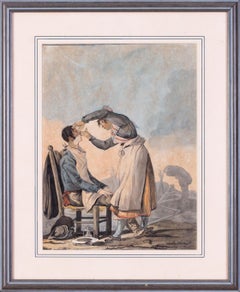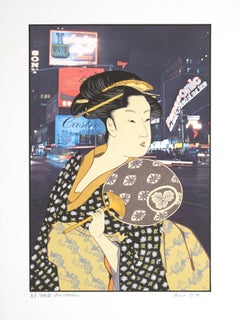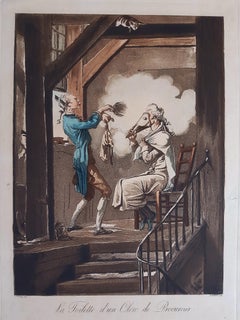Carle Vernet (Antoine Charles Horace Vernet) Art
to
1
3
2
4
1
3
2
4
1
Overall Height
to
Overall Width
to
1
5
3
2
1
1
1
1
1
2
2
1
2
7
6,828
3,108
2,517
1,217
2
2
1
1
1
Artist: Carle Vernet (Antoine Charles Horace Vernet)
Galloping rider by Carle Vernet - Drawing on paper 25x30 cm
By Carle Vernet (Antoine Charles Horace Vernet)
Located in Geneva, CH
Carle VERNET is an artist born in France in 1758 and died in 1836. His works have been sold at public auction 962 times, mainly in the Print-Multiple category.
This work is sold with...
Category
Early 19th Century Realist Carle Vernet (Antoine Charles Horace Vernet) Art
Materials
Carbon Pencil
"Les Jockeys Montes" by Vernet
By Carle Vernet (Antoine Charles Horace Vernet)
Located in Bristol, CT
Carle Vernet print Les Jockeys Montes
Art Sz: 5 1/2"H x 9"W
Frame Sz: 14"H x 17"W
w/ French mat & birdseye maple frame
Antoine Charles Horace Vernet, better known as Carle Vernet...
Category
20th Century Carle Vernet (Antoine Charles Horace Vernet) Art
Materials
Lithograph
"Les Accidents De La Chasse" By Carle Vernet
By Carle Vernet (Antoine Charles Horace Vernet)
Located in Bristol, CT
Art Sz: 9 1/2"H x 12"W
Frame Sz: 16 1/2"H x 19"W
Custom framed by J. Pocker & Son
Antoine Charles Horace Vernet, better known as Carle Vernet (14 August 1758 – 17 November 1836), ...
Category
18th Century Carle Vernet (Antoine Charles Horace Vernet) Art
Materials
Paper
Pair of 18th Century watercolour drawings by Old Master Carle Vernet
By Carle Vernet (Antoine Charles Horace Vernet)
Located in Petworth, West Sussex
Carle Vernet (French, 1758 – 1836)
‘La Marchande de Coco’; and ‘La Tour de Babbe d’un Charbonnier’
Ink, watercolour on paper
Both signed C Vernet and Carle Vernet (lower left and lower right respectively)
12.1/4 x 9 in. (31 x 22.8 cm.) A pair
Vernet was born in Bordeaux. At the age of five, he showed an extraordinary passion for drawing horses, but went through the regular academical course as a pupil of his father and of Nicolas-Bernard Lépicié. Strangely, after winning the grand prix (1782), he seemed to lose interest in the profession, and his father had to recall him back from Rome to France to prevent him from entering a monastery.
In his Triumph of Aemilius Paulus, he broke with tradition and drew the horse with the forms he had learnt from nature in stables and riding-schools. His hunting-pieces, races, landscapes, and work as a lithographer were also very popular.
Carle's sister was executed by the guillotine during the Revolution. After this, he gave up art.
When he again began to produce under the French Directory (1795–1799), his style had changed radically. He started drawing in minute detail battles and campaigns to glorify Napoleon. His drawings of Napoleon...
Category
18th Century Old Masters Carle Vernet (Antoine Charles Horace Vernet) Art
Materials
Paper, Ink, Watercolor
Soleil je Viens [...] - Original Lithograph by C. Vernet - Early 19th Century
By Carle Vernet (Antoine Charles Horace Vernet)
Located in Roma, IT
"Soleil je viens voir pour la dernier fois" is an original lithograph realized by Carle Vernet (1758-1836).
Not signed.
Good conditions.
The artwork represents an interesting woma...
Category
Early 19th Century Carle Vernet (Antoine Charles Horace Vernet) Art
Materials
Lithograph
Related Items
"Ohisai After Utamaro, " original color lithograph by Michael Knigin
By Michael Knigin
Located in Milwaukee, WI
"Ohisai After Utamaro" is an original color lithograph by Michael Knigin. The artist signed the piece lower right and titled it lower left. This is the artist's proof. This piece fea...
Category
1970s Pop Art Carle Vernet (Antoine Charles Horace Vernet) Art
Materials
Lithograph
The Abduction of the Sabine Women , a Renaissance drawing by Biagio Pupini
Located in PARIS, FR
This vigorous drawing has long been attributed to Polidoro da Caravaggio: The Abduction of the Sabine Women is one of the scenes that Polidoro depicted between 1525 and 1527 on the façade of the Milesi Palazzo in Rome. However, the proximity to another drawing inspired by this same façade, kept at the Ecole des Beaux-Arts, and to other drawings inspired by Polidoro kept at the Musée du Louvre, leads us to propose an attribution to Biagio Pupini, a Bolognese artist whose life remains barely known, despite the abundant number of drawings attributed to him.
1. Biagio Pupini, a Bolognese artist in the light of the Roman Renaissance
The early life of Biagio Pupini, an important figure of the first half of the Cinquecento in Bologna - Vasari mentions him several times - is still poorly known. Neither his date of birth (probably around 1490-1495) nor his training are known. He is said to have been a pupil of Francesco Francia (1450 - 1517) and his name appears for the first time in 1511 in a contract with the painter Bagnacavallo (c. 1484 - 1542) for the frescoes of a church in Faenza. He then collaborated with Girolamo da Carpi, at San Michele in Bosco and at the villa of Belriguardo.
He must have gone to Rome for the first time with Bagnacavallo between 1511 and 1519. There he discovered the art of Raphael, with whom he might have worked, and that of Polidoro da Caravaggio. This first visit, and those that followed, were the occasion for an intense study of ancient and modern art, as illustrated by his abundant graphic production.
Polidoro da Caravaggio had a particular influence on the technique adopted by Pupini. Executed on coloured paper, his drawings generally combine pen, brown ink and wash with abundant highlights of white gouache, as in the drawing presented here.
2. The Abduction of the Sabine Women
Our drawing is an adaptation of a fresco painted between 1525 and 1527 by Polidoro da Caravaggio on the façade of the Milesi Palace in Rome. These painted façades were very famous from the moment they were painted and inspired many artists during their stay in Rome. These frescoes are now very deteriorated and difficult to see, as the palace is in a rather narrow street.
The episode of the abduction of the Sabine women (which appears in the centre of the photo above) is a historical theme that goes back to the origins of Rome and is recounted both by Titus Livius (Ab Urbe condita I,13), by Ovid (Fasti III, 199-228) and by Plutarch (II, Romulus 14-19). After killing his twin brother Romus, Romulus populates the city of Rome by opening it up to refugees and brigands and finds himself with an excess of men. Because of their reputation, none of the inhabitants of the neighbouring cities want to give them their daughters in marriage. The Romans then decide to invite their Sabine neighbours to a great feast during which they slaughter the Sabines and kidnap their daughters.
The engraving made by Giovanni Battista Gallestruzzi (1618 - 1677) around 1656-1658 gives us a good understanding of the Polidoro fresco, allowing us to see how Biagio Pupini reworked the scene to extract this dynamic group.
With a remarkable economy of means, Biagio Pupini takes over the left-hand side of the fresco and depicts in a very dense space two main groups, each consisting of a Roman and a Sabine, completed by a group of three soldiers in the background (which seems to differ quite significantly from Polidoro's composition).
The balance of the drawing is based on a very strongly structured composition. The drawing is organised around a median vertical axis, which runs along both the elbow of the kidnapped Sabine on the left and the foot of her captor, and the two main diagonals, reinforced by four secondary diagonals. This diamond-shaped structure creates an extremely dynamic space, in which centripetal movements (the legs of the Sabine on the right, the arm of the soldier on the back at the top right) and centrifugal movements (the arm of the kidnapper on the left and the legs of the Sabine he is carrying away, the arm of the Sabine on the right) oppose each other, giving the drawing the appearance of a whirlpool around a central point of support situated slightly to the left of the navel of the kidnapper on the right.
3. Polidoro da Caravaggio, and the decorations of Roman palaces
Polidoro da Caravaggio was a paradoxical artist who entered Raphael's (1483 - 1520) workshop at a very young age, when he oversaw the Lodges in the Vatican. Most of his Roman work, which was the peak of his career, has disappeared, as he specialised in facade painting, and yet these paintings, which are eminently visible in urban spaces, have influenced generations of artists who copied them abundantly during their visits to Rome.
Polidoro Caldara was born in Caravaggio around 1495-1500 (the birthplace of Michelangelo Merisi, known as Caravaggio, who was born there in 1571), some forty kilometres east of Milan. According to Vasari, he arrived as a mason on the Vatican's construction site and joined Raphael's workshop around 1517 (at the age of eighteen according to Vasari). This integration would have allowed Polidoro to work not only on the frescoes of the Lodges, but also on some of the frescoes of the Chambers, as well as on the flat of Cardinal Bibiena in the Vatican.
After Raphael's death in 1520, Polidoro worked first with Perin del Vaga before joining forces with Maturino of Florence (1490 - 1528), whom he had also known in Raphael's workshop. Together they specialised in the painting of palace façades. They were to produce some forty façades decorated with grisaille paintings imitating antique bas-reliefs.
The Sack of Rome in 1527, during which his friend Maturino was killed, led Polidoro to flee first to Naples (where he had already stayed in 1523), then to Messina. It was while he was preparing his return to the peninsula that he was murdered by one of his assistants, Tonno Calabrese, in 1543.
In his Vite, Vasari celebrated Polidoro as the greatest façade decorator of his time, noting that "there is no flat, palace, garden or villa in Rome that does not contain a work by Polidoro". Polidoro's facade decorations, most of which have disappeared as they were displayed in the open air, constitute the most important lost chapter of Roman art of the Cinquecento. The few surviving drawings of the painter can, however, give an idea of the original appearance of his murals and show that he was an artist of remarkable and highly original genius.
4. The façade of the Milesi Palace
Giovanni Antonio Milesi, who commissioned this palace, located not far from the Tiber, north of Piazza Navona, was a native of the Bergamo area, like Polidoro, with whom he maintained close friendly ties. Executed in the last years before the Sack of Rome, around 1526-1527, the decoration of Palazzo Milesi is considered Polidoro's greatest decorative success.
An engraving by Ernesto Maccari made at the end of the nineteenth century allows us to understand the general balance of this façade, which was still well preserved at the time. The frescoes were not entirely monochrome, but alternated elements in chiaroscuro simulating marble bas-reliefs and those in ochre simulating bronze and gold vases...
Category
16th Century Old Masters Carle Vernet (Antoine Charles Horace Vernet) Art
Materials
Ink, Gouache, Pen
"De Quoi! De Quoi! Votre Dot?, " an Original Lithograph by Honoré Daumier
By Honoré Daumier
Located in Milwaukee, WI
"De Quoi! De Quoi! Votre Dot?" is an original lithograph 3/3 D. 390 (Charivari) by Honore Daumier. It depicts an odd-looking man and a beautifully-dressed woman in conversation. Ther...
Category
Mid-19th Century Carle Vernet (Antoine Charles Horace Vernet) Art
Materials
Lithograph
"Un Apres Midi au Champs de Courses, " Original Color Lithograph signed by Batet
By Francois Batet
Located in Milwaukee, WI
"Un Apres Midi au Champs de Courses" is an original color lithograph by Francois Batet. The artist signed the piece in the lower right and wrote the edition number (11/200) in the lo...
Category
1980s Carle Vernet (Antoine Charles Horace Vernet) Art
Materials
Lithograph
Fine 1700's Italian Old Master Ink & Wash Drawing Roman Allegorical Insubria
Located in Cirencester, Gloucestershire
'Insubria'
Italian School, 18th century
ink and wash drawing on paper, framed within a light oak wood frame (behind glass)
image size: 10.5 x 7 inches
overall framed: 17 x 13 inches
...
Category
18th Century Old Masters Carle Vernet (Antoine Charles Horace Vernet) Art
Materials
Ink, Watercolor, Archival Paper
Follower of Francesco Guardi, Figures in a Mediterranean port by a Roman Arch
By Francesco Guardi
Located in Harkstead, GB
A lively, well executed sketch painted by a 19th century follower of Francesco Guardi
Follower of Francesco Guardi, 19th Century
Figures by a Roman Arch
Watercolour with ink and sc...
Category
19th Century Old Masters Carle Vernet (Antoine Charles Horace Vernet) Art
Materials
Paper, Ink, Watercolor
Free Shipping
H 6.5 in W 5 in D 1 in
Salvador Dali - The Vision - Original Lithograph
By Salvador Dalí
Located in Collonge Bellerive, Geneve, CH
Salvador Dali - The Vision - Original Lithograph
Joseph FORET, Paris, 1957
PRINTER : Detruit.
SIGNATURE : plate signed by Dali.
LIMITED : 233 copies.
SIZE : 41 x 33 cm
REFERENCES ...
Category
1950s Surrealist Carle Vernet (Antoine Charles Horace Vernet) Art
Materials
Lithograph
Fine 1700's Italian Old Master Ink & Wash Drawing Roman Allegorical Figure Fame
Located in Cirencester, Gloucestershire
'Fame'
Italian School, 18th century
ink and wash drawing on paper, framed within a light oak wood frame (behind glass)
image size: 10.5 x 7 inches
overall framed: 17 x 13 inches
cond...
Category
18th Century Old Masters Carle Vernet (Antoine Charles Horace Vernet) Art
Materials
Watercolor, Archival Paper, Ink
Chez Panisse Restaurant Birthday Celebration: Original Goines Graphic Art Poster
By David Lance Goines
Located in Alamo, CA
This original graphic art lithographic poster entitled "Chez Panisse Restaurant and Cafe" was created by David Lance Goines in 1989 in his Berkeley studio...
Category
Late 20th Century Carle Vernet (Antoine Charles Horace Vernet) Art
Materials
Lithograph
David Roberts' 19th Century Duo-tone Lithograph: Colossus of the Temple of Wady
By David Roberts
Located in Alamo, CA
"Colossus in Front of the Temple of Wady Saboua, Nubia" is a 19th century half-folio sized duo-tone lithograph from the "The Holy Land, Syria, Idumea, Arabia, Egypt and Nubia" volume of David Roberts’ large folio edition, published in London by F. G. Moon in 1843. The lithographs were prepared by Louis Haghe (1806-1885) from drawings and paintings by Roberts. The resultant large folio editions of 'The Holy Land' and 'Egypt & Nubia' are considered by many to be the most beautiful lithographically illustrated works issued in the 19th century.
This half page lithograph depicts two colossal statues that stood in front of Temple of Wady in Nubia, each measuring 14 feet high and 5 feet across at the shoulders. Both figures hold a long staff with a symbolic rams head and disc on top. The second colossus lies on the ground. Three guards are in conversation with two other individuals at the base of the upright statue. Nubia is the area between Aswan in southern Egypt and Khartoum in central Sudan. It was the site of one of the earliest civilizations of ancient Africa...
Category
1840s Realist Carle Vernet (Antoine Charles Horace Vernet) Art
Materials
Lithograph
H 23.13 in W 19.63 in D 1.25 in
Cinnamon Bear: An Original 19th Century Audubon Hand-colored Lithograph
By John James Audubon
Located in Alamo, CA
This is an original 19th century John James Audubon hand colored lithograph entitled "Cinnamon Bear", No. 26, Plate CXXVII, 127 from Audubon's "Quadrupeds of North America", printed ...
Category
Mid-19th Century Naturalistic Carle Vernet (Antoine Charles Horace Vernet) Art
Materials
Lithograph
Fine 1700's Italian Old Master Ink & Wash Drawing Roman Allegorical Providenza
Located in Cirencester, Gloucestershire
'Providenza'
Italian School, 18th century
ink and wash drawing on paper, framed within a light oak wood frame (behind glass)
image size: 10.5 x 7 inches
overall framed: 17 x 13 inche...
Category
18th Century Old Masters Carle Vernet (Antoine Charles Horace Vernet) Art
Materials
Watercolor, Ink, Archival Paper
Previously Available Items
La toilette d’un Clerc de Procureur - Etching and Aquatint by C. Vernet - 1816
By Carle Vernet (Antoine Charles Horace Vernet)
Located in Roma, IT
La toilette d’un clerc de procureur is an original colour aquatint, realized by Carle Vernet in 1816.
In very good conditions.
The artwork represents a satiric scene of the toilet...
Category
1810s Carle Vernet (Antoine Charles Horace Vernet) Art
Materials
Etching, Aquatint
Carle Vernet (antoine Charles Horace Vernet) art for sale on 1stDibs.
Find a wide variety of authentic Carle Vernet (Antoine Charles Horace Vernet) art available for sale on 1stDibs. If you’re browsing the collection of art to introduce a pop of color in a neutral corner of your living room or bedroom, you can find work that includes elements of red and other colors. You can also browse by medium to find art by Carle Vernet (Antoine Charles Horace Vernet) in lithograph, paper, carbon pencil and more. Much of the original work by this artist or collective was created during the 18th century and is mostly associated with the Old Masters style. Not every interior allows for large Carle Vernet (Antoine Charles Horace Vernet) art, so small editions measuring 9 inches across are available. Customers who are interested in this artist might also find the work of Antoine Calbet, Charles Kiffer, and Gaston Hoffmann. Carle Vernet (Antoine Charles Horace Vernet) art prices can differ depending upon medium, time period and other attributes. On 1stDibs, the price for these items starts at $334 and tops out at $5,559, while the average work can sell for $750.
Artists Similar to Carle Vernet (Antoine Charles Horace Vernet)
Robert Sargent Austin, R.A., P.R.E., P.R.W.S.


![je carle Soleil je Viens [...] - Original Lithograph by C. Vernet - Early 19th Century](https://a.1stdibscdn.com/carle-vernet-antoine-charles-horace-vernet-prints-works-on-paper-soleil-je-viens-original-lithograph-by-c-vernet-early-19th-century-for-sale/a_6503/a_75476121613424099821/miz26501_master.jpg?width=240)


